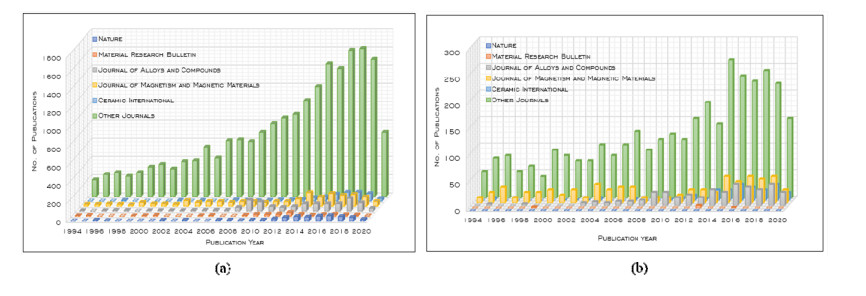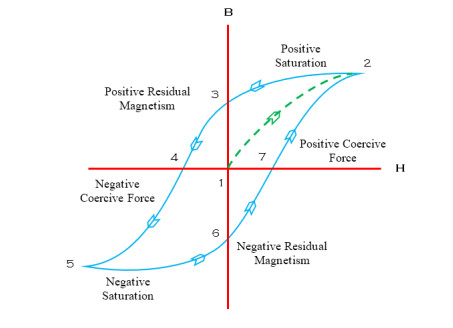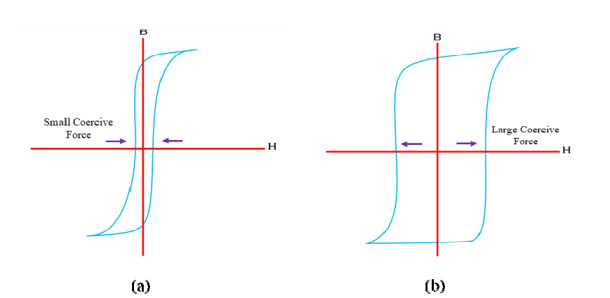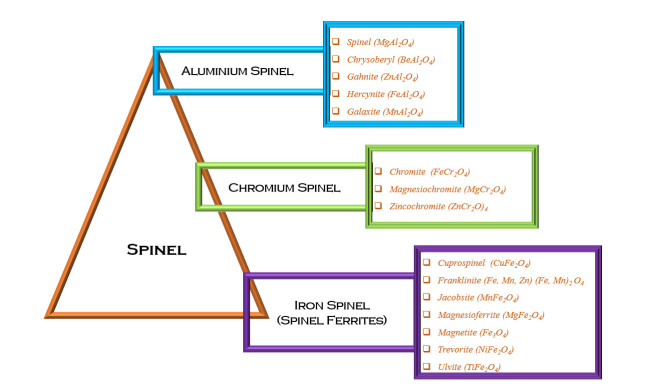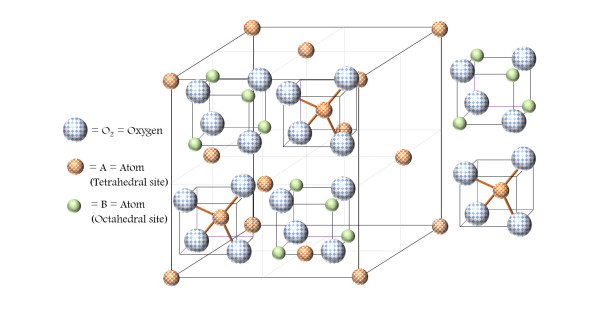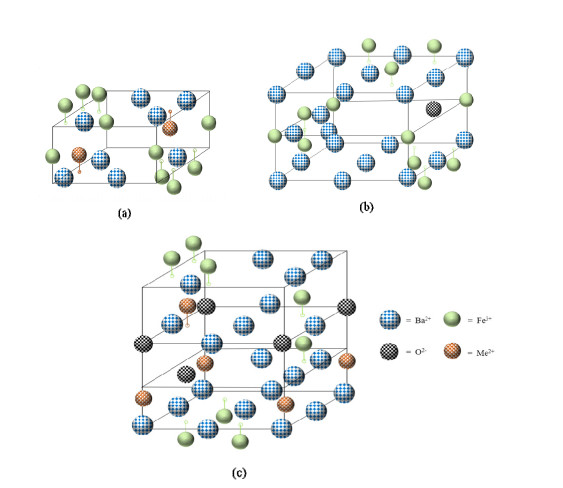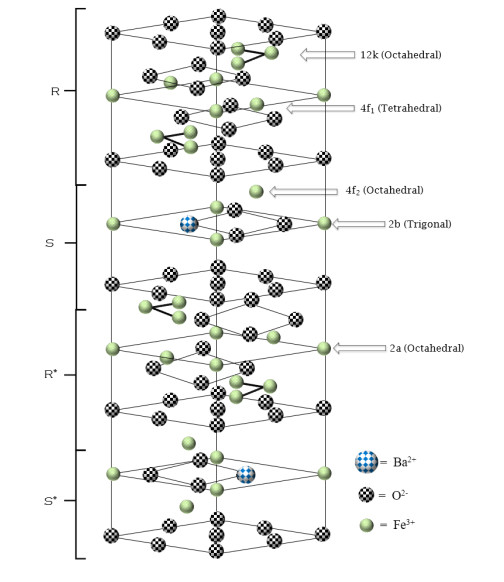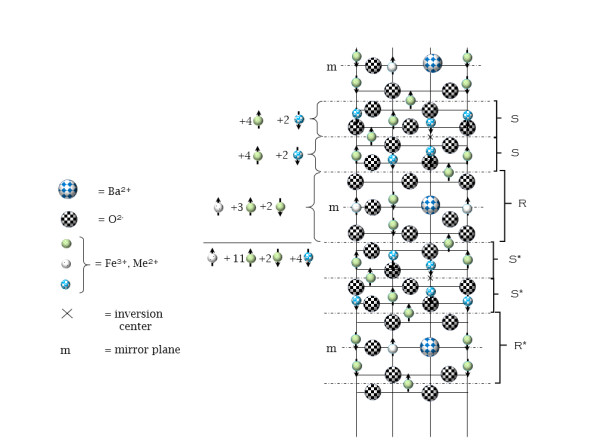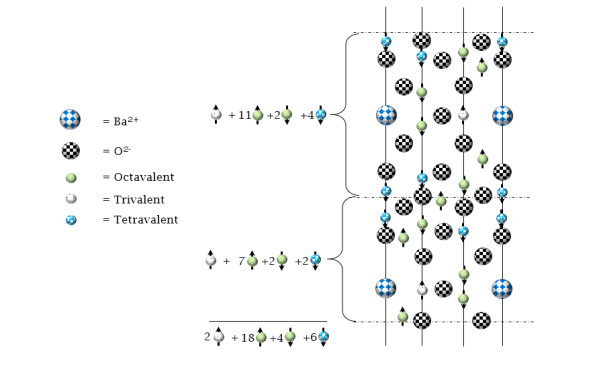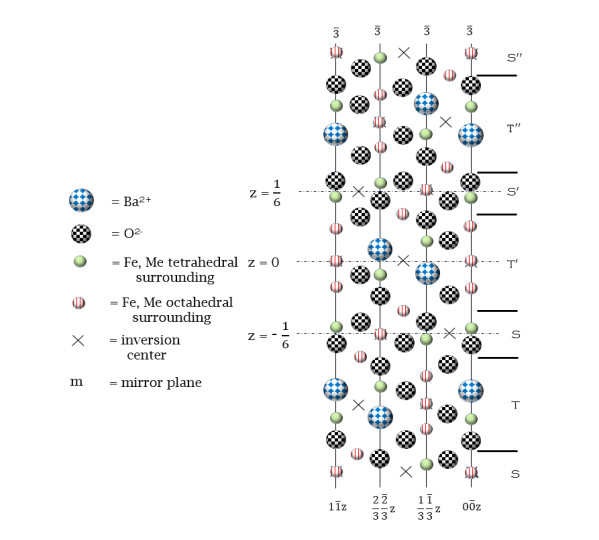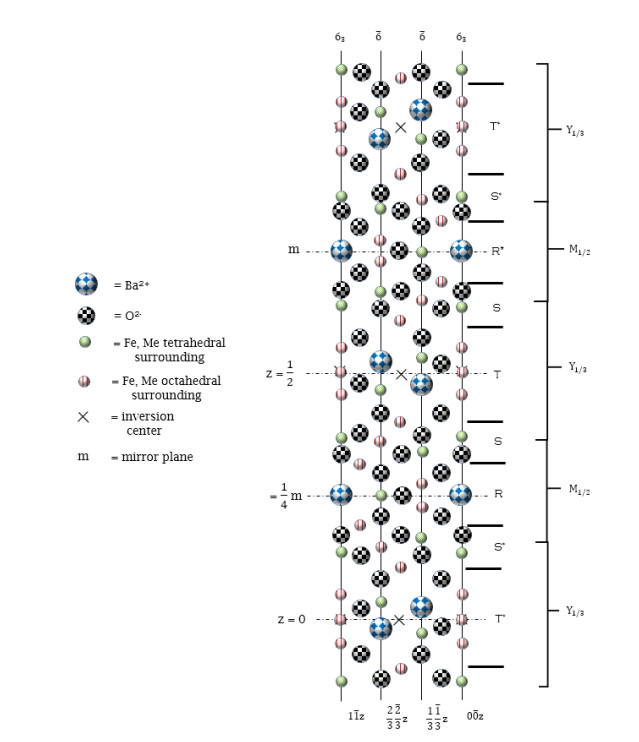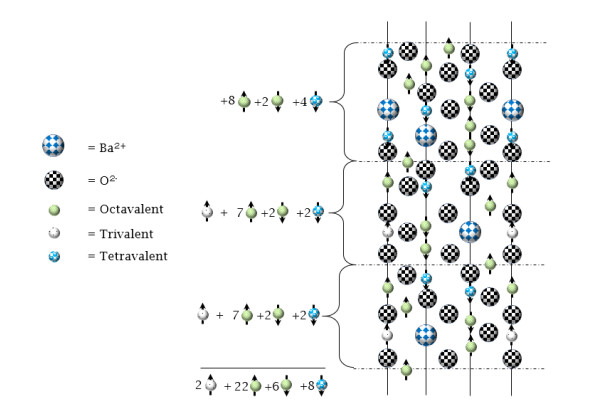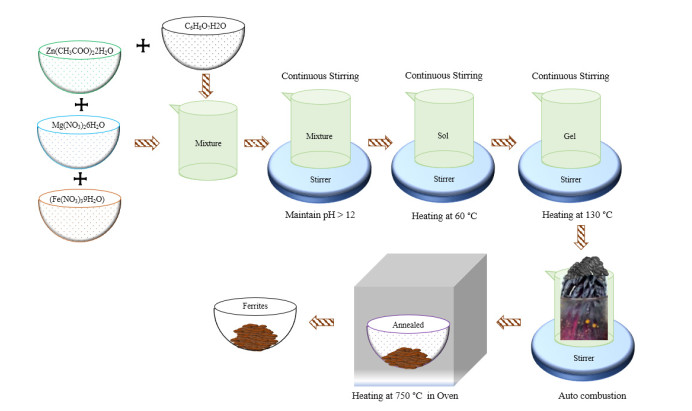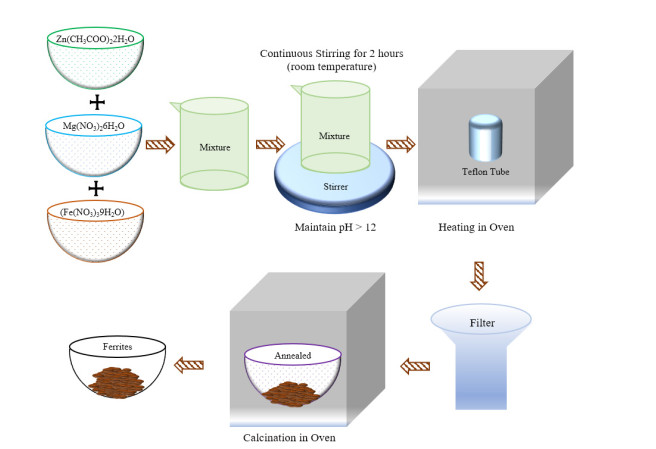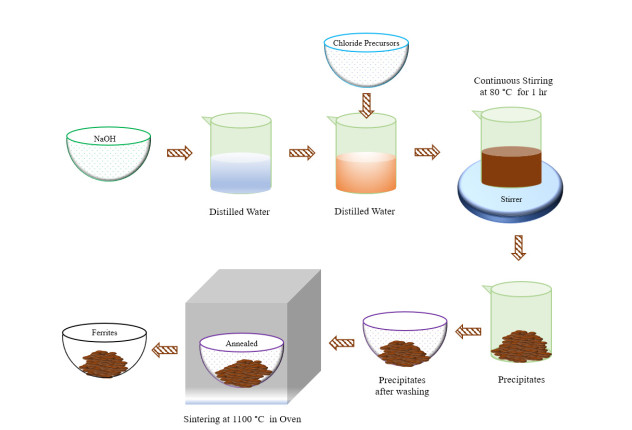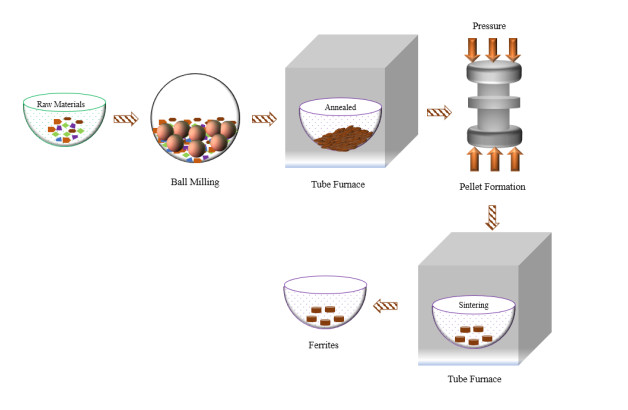The research on ferrites is fast moving owing to their exponentially growing usage in magnetic shielding, magnetic biosensors, magnetic recording devices, information storage, mobile communication, electronic devices, gyromagnetic device, medical devices, transformers, pollution control, catalysis, and pigments. This review comprises the present state of the art on hexagonal ferrites (HFs) and spinel ferrites (SFs). The article covers the background, properties, classification schemes, synthesis and characterization of ferrites. It focuses on a comparative understanding of four synthesis routes, magnetic properties and characterization of the ferrites. The article emphases X-ray diffraction, scanning electron microscopy, transmission electron microscopy, vibrating sample magnetometer, spectroscopy, thermal analysis and vector network analyser results. The present work is meant for the faster understanding of this research area.
1.
Introduction
Ancient humans have discovered the magnetism from natural magnetic stone "lodestone", however, documented information on magnetism was first reported by Dr. William Gilbert in 1600 [1,2]. The ferrites were first time synthesized in 1930 [3,4]. There are primarily three types of magnetic materials viz. ferromagnetic, paramagnetic, and diamagnetic. Ferrites are ceramic materials made from iron oxides with chemical addition of one or more metals. Ferrites are the compounds of two metallic oxides consisting iron oxide and any of bivalent elements (Ni, Mn, Mg, Zn, Cu, Fe, etc.) [1]. Ferrites exhibit excellent electrical and magnetic properties. The ferrimagnetic materials have unequal magnitude of magnetic moments and opposite directions alignment while subjected to magnetic field. The magnitude of magnetic moment is more in one direction than in the other and this behaviour is called ferrimagnetism. The advantages of ferrites include high electrical resistivity, low eddy current loss, high permeability and time-temperature stability, wide frequency range, shape versatility, low cost, etc. [5]. Ferrites have multitude usages such as permanent magnet, magnetic shielding, magnetic sensors, magnetic recordings, information storage, mobile communication, electronic devices, gyromagnetic device, medical devices, transformers, sensors, pollution control, catalysis, pigments, etc. Ferrites applications are mutually inclusive in semiconductor physics, electronics, surface science, electrochemistry, optics, energy storage, photo-catalyst, gas sensors, magnetism, high density information storage, ferro-fluids, biomedical sciences, magnetic drug delivery, etc. [6,7,8,9,10,11,12,13,14]. The electrical and magnetic properties of ferrites at the nano-level determines their application for miniaturization of electronics devices. The nano-sized ferrites are used for high density magnetic storage media, high speed digital tape, disk recordings, microwave devices, etc. [15].
There are a number of review articles are available in literature on ferrite materials focusing different aspects (Table 1). The review articles on historical perspective of the technological development of ferrites [16], the synthesis, properties, and applications of hexaferrite ceramics particularly focusing X and U type ferrites [2] have been reported in the literature. The magnetic properties, magnetic materials, synthesis of anisotropic magnetic nanoparticles and their potential applications were reviewed [4]. The application of ferrites as microwave absorber has been discussed and the simple preparation method, nano-range of particle size, unique crystal structure, and better magnetic properties were highlighted [17,18]. The review article aiming the application of the ferrites in sensors [5,8], biomedicine [6], catalysts [19,20], waste water treatment [21,22,23], and magnetic resonance imaging [24,25] were reported. The authors have discussed application of ferrites in electronic circuits as inductors, high frequency systems, power delivering devices, electromagnetic interference suppression, biotechnology, etc. [12]. Furthermore, the chemical and crystallographic structures [26], influence of intrinsic parameters [27], and electrochemical synthesis method [28] of ferrites have been reviewed in the literatures. The scopes of previously published review papers on ferrites are summarized in Table 1.
A data was collected on year wise publications related to the ferrites in Elsevier, Sage, Willy, Springer, Taylor Francis, and Inter-science publication houses between 1994-2020 (searched between 15th-20th March 2020) to showcase the rapid growth in this field of research. Figure 1a shows year-wise publications in different journals once "Spinel Ferrite" was entered as a keyword. In total, 18722 articles were found collectively in the journals published by earlier listed publication houses. Similarly, Figure 1b represents the number of articles (total 12954 articles) on hexagonal ferrites by searching with the keyword "Hexagonal Ferrite". The top five Journals based on impact factor, relevance to the field of study, and number of publications were selected for the study.
Owing to rapid development in the state of the art on ferrites, it is timely to present a review article that covers background, classification, synthesis methods and characterization of spinel ferrites and hexagonal ferrites. A systematic review on X-ray diffraction, scanning electron microscopy, transmission electron microscopy and spectroscopy results is included. The discussion on the magnetic properties, thermal analysis, and microwave absorbing properties of spinel ferrites and hexagonal ferrites is also presented.
2.
Properties of ferrites
Ferrites exhibit permanent type of magnetism referred as ferrimagnetism. Ferrimagnetism was originally proposed by Neel to define the magnetic order phenomenon in ferrites [29]. In ferrimagnetism, the magnetic moments of atoms align themselves in both parallel (as in ferromagnetism) and antiparallel (as in anti-ferromagnetism) directions. The overall magnetic field of ferrite is lesser strong than ferromagnetic materials because there is a partial cancellation of magnetic field [30]. The ferrimagnetic materials exhibit a magnetic moment even in the absence of magnetic field (spontaneous magnetic moment) similar to ferromagnetic materials and the hysteresis phenomenon below the Curie temperature as shown in Figure 2. The paramagnetic behaviour of ferrimagnetic materials above the Curie temperature are quite similar to ferromagnetic materials [31]. The significant properties of ferrites include high electrical resistivity, low eddy current and dielectric losses, high saturation magnetization, high permeability, moderate permittivity, spontaneous magnetization and conductivity behaviour. In comparison with diamagnetics or paramangetics the saturation magnetization of ferrites is high, but as ferrimagnetics they exhibit saturation magnetization significantly lower than ferromagnetics, like amorphous or nanocrystalline alloys. So in comparison with other materials considered as magnetic materials the saturation magnetization of ferrites is not that high. The same is with permeability.
3.
Classification of ferrites
The ferrites are ionic compounds with certain double oxides of iron and other metals. The magnetic properties of ferrites depend on the ions they contain. Several ferrites are found as naturally occurring minerals in rocks with impure state [32]. Ferrites are dark grey or black, hard and brittle ceramic materials. These materials are synthesized by heat treating the transition metal oxides. This section includes classification of ferrites based on magnetic properties and crystal structures [33].
3.1. According to magnetic properties
According to the magnetic properties, ferrites exhibiting spontaneous magnetization are divided into two groups, viz. soft ferrites and hard ferrites. Soft ferrites have low coercivity of magnetism [2] (shown in Figure 3a) and hard ferrites have high coercivity of magnetism [2] (shown in Figure 3b).
3.1.1. Soft ferrites
Soft ferrites are the ferrimagnetic materials that do not hold their magnetism after being magnetized. Soft ferrites have a steeply rising magnetisation curve, narrow and small hysteresis loop, and small energy losses during magnetisation. These materials can be produced by heating and slow cooling and can easily be magnetized and demagnetized. Soft ferrites are ceramic insulators with cubic crystal structure MFe2O4, where M is transition metal ions, such as Ni, Mn, Zn, etc. Soft ferrites have high values of susceptibility and permeability (for example, Nickel Zinc ferrite has 1.26 × 10−5-2.89 × 10−3 H/m), low eddy current losses, and low retentivity and coercivity [2]. Therefore, soft ferrites are used in electromagnets, computer data storage, cores of transformer, telephone signal transmitters and receiver, etc.
3.1.2. Hard ferrites
Hard ferrites are also known as permanent magnetic materials because they can hold their magnetism after being magnetized. Hard ferrites are those ferrimagnetic materials which have gradually rising magnetisation curve, large hysteresis loop and large energy losses during magnetisation. Hard ferrites can be produced by heating and sudden cooling and cannot be easily magnetized and demagnetized. Hard ferrites are compound of iron and barium or strontium oxides. Hard ferrites have high saturation flux density, low susceptibility and permeability, high eddy current losses, and high retentivity and coercivity. Therefore, hard ferrites are used in permanent magnet, DC magnet, loud speakers, etc.
3.2. According to crystal structure
Ferrites have variety of crystal structures. Based on their crystal structures, ferrites can be classified in four types, i.e., spinel, garnet, ortho, and hexagonal ferrites (Table 2).
4.
Spinel ferrites
The spinel group consists the chemical classes of oxides, germinate and silicates. There are 24 mineral species have been approved in the spinel group [34]. The spinels are metal oxides with the general composition AB2O4, where, A could be Mg, Fe, Zn, Mn, Ni, etc., B could be Al, Cr or Fe, and O is oxygen. The spinel group can be divided in three series (Figure 4), i.e., aluminium-spinel, chromium-spinel and iron-spinel series. The members of aluminium spinel are spinel (MgAl2O4), gahnite (ZnAl2O4), hercynite (FeAl2O4) and galaxite (MnAl2O4). The aluminium spinels are harder, transparent and less-denser than other spinel, and used in the jewellery industry. The chromium spinel is hard, metallic, and black oxide mineral. The principle member of chromium spinel series is chromite (FeCr2O4) and another member is magnesiochromite (MgCr2O4). The chromium-spinels are found as brittle masses in peridotites, serpentines, igneous and metamorphic rock. The iron-spinel (spinel ferrite) series minerals are hard, black to brownish, and having low coercivity. These spinels are found as masses in igneous, metamorphic, granite pegmatites, stony meteorites and high temperature sulphide veins [35,36].
The iron spinel is found as Cuprospinel (CuFe2O4), Franklinite [(Fe, Mn, Zn)(Fe, Mn)2O4], Jacobsite (MnFe2O4), Magnesioferrite (MgFe2O4), Magnetite (Fe3O4), Trevorite (NiFe2O4), Ulvite (TiFe2O4) (Table 3) [37,38]. Cuprospinel was first characterized by the Australian mineralogist Ernest Henry Nickel, in 1973. This mineral is abundantly found in Canada [39,40,41]. Cuprospinel (CuFe2O4) is an inverse spinel in which the copper substitutes some of the iron cations in the structure. The structure of Cuprospinel (denoted as Copper ferrite) is similar to magnetite. The octahedral sites of Cuprospinel are occupied by copper (Cu2+), which occupies octahedral sites, and tetrahedral sites are torn apart in iron (Fe2+ and Fe3+). Fe2+ and Fe3+ occupy some of the octahedral sites and some of the tetrahedral sites [42]. Cuprospinel attains stable structure at elevated temperatures. The structure and chemical properties of Cuprospinel makes it a suitable catalyst in the water-gas shift reaction for hydrogen production [43,44]. Cuprospinel is widely used as catalyst for A3 coupling of aldehydes, amine with phenylacetylene to give the corresponding propargylamines, C-O cross-coupling between phenols and aryl halides, C-H activation in Mannich type reaction etc. Franklinite (Zn, Fe2+)(Fe3+)2O4 is an is a dark black, metallic, and opaque oxide mineral belonging to the normal spinel subetaoup's iron series. Franklinite has been used as an ore of zinc at Franklin and Sterling Hill mines, New Jersey [34,45,46,47,48]. Jacobsite (MnFe2O4) is a black, grey and opaque mineral iron oxide containing manganese. The mineral was first discovered at Jakobsberg Mine, Sweden in 1869. Jacobsite forms a solid solution series with magnetite. The associated minerals with manganese includes hausmannite, braunite, pyrolusite, coronadite, hematite, and magnetite. Jacobsite is used for photocatalytic applications [34,49]. Magnesioferrite (MgFe2O4) is a soft magnetic semiconducting materials with excellent chemical stability and partial inverse spinel structure (Feδ3+Mg1-δ2+)A[Mgδ2+Fe2-δ3+]BO4) [34,50,51]. Magnetite Fe3+[Fe+Fe3+]O4 is ferrimagnetic iron ore that can become a permanent magnet on magnetization [52]. It is having a stronger magnetic field than all other naturally occurring minerals on the earth. Naturally magnetized pieces of magnetite (earlier known as lodestone) [34,53]) attract small pieces of iron. The small grains of magnetite are found in almost all igneous and metamorphic rocks. Magnetite is a black or brownish-black mineral with a metallic lustre used in water purification, audio recording, drug delivery, magnetic resonance technology, etc. [29,54]. Trevorite (NiFe23+O4) is a rare nickel-iron oxide mineral that belongs to the spinel group [34,55] This black-streaked mineral is infusible and insoluble in most acids [56]. Trevorite is a ferrimagnetic material with inverse spinel structure [57]. Ulvite was first reported from Sodra Ulvon, Sweden [34,58]. Ulvite or Ulvospinel (TiFe22+O4) mineral is an iron titanium oxide with brown black metallic isometric crystals [59]. In the ore, ulvite (ferro-otho-titanate) appears in a blend of various spinels [60].
The SFs are group of ferrites having a face centered cubic crystal structure with A2+ B23+ O42- formulation (A2+ = Fe2+, Zn2+, Co2+, Mn2+, Ni2+, Mg2+, etc.) [6,28,64]. "A" and "B" can be trivalent, divalent, or quadrivalent cations and the anions are oxides. Anions could be either d or f block metals, 1A, B or 2A, B metals or group 3A or 4A atoms [65]. The unit cell of spinel comprises 16 trivalent ions, 32 oxygen, and 8 divalent metal ions [66]. The array of the oxygen ions discloses two types of interstices, that could be occupied by the metal ions. These interstices are referred as tetrahedral or "A" sites and octahedral or "B" sites. The unit cell of the spinel structure consists of two groups of octants (four cubes) as shown in Figure 5. The ionic sites are unlike in 2 octants sharing a corner or a face and the similar in 2 octants sharing an edge. There are 64 tetrahedral and 32 octahedral positions for cations [6,8,67]. In SFs, the octahedral sites are larger than tetrahedral sites and only 8 tetrahedral and 16 octahedral positions are occupied by cations. In SFs, the magnetic moment of cations at tetrahedral sites are oriented in the same direction but antiparallel to that of octahedral site [6].
Based on the distribution of cations in tetrahedral and octahedral sites, the SFs can be categorized as normal spinel, inverse spinel, and mixed spinel [8,28,32,68]. The normal and inverse spinel type structure was discovered by Barth and Posnjak. The mixed spinel structure was discovered by Machatschki [66]. In normal spinel, one type of cations (either divalent or trivalent) occupies the octahedral "B" site, the divalent cations lodge tetrahedral "A" sites, and trivalent cations occupy the octahedral "B" site. The formula (M2+)A[Me3+]BO4 shows normal spinel composition, where M denotes divalent ions occupy one-eighth of the tetrahedral site, Me for trivalent ions occupy one half of the octahedral site and the ionic distribution of the octahedral "B" sites are represented by square brackets [65]. The typical example of normal spinel is bulk ZnFe2O4 where Zn2+ cations occupy tetrahedral sites and Fe3+ cations incorporate at octahedral sites [6,8,28,67,68,69,70,71]. In the inverse spinel, all divalent cations occupy the octahedral sites whereas half of the trivalent cations occupy tetrahedral "A" sites and other half occupy the octahedral "B" sites. The formula, (Me3+)A[M2+Me3+]BO4 represents inverse spinel. A typical example of inverse spinel is Fe3O4, in which Fe3+ serve as trivalent cation and Fe2+ as divalent cations [6,8,28,31,67,68,69,70,71,72,73]. In random spinel structure, there is an equal distribution of cations over two sites based on the site ratio and stoichiometry, e.g., (Mδ2+Me1-δ2+)A[M1-δ2+Me1+δ3+]BO4), where, δ is inversion parameter. The value of δ depends on the preparation method and the constituents of the ferrites. If δ = 1, then spinel, is a complete normal spinel whereas, for δ = 0, complete inverse spinel exists. If δ ranges between these two extreme values than spinel is called mixed spinel, for example δ = 1/3 [67,68]. The typical examples of mixed spinel is MgFe2O4 [70].
SFs have a combination of magnetic and insulating characteristics. SFs are widely used due to their efficacy, variability and flexibility. SFs are soft magnetic materials with higher electrical resistivity, lower eddy current losses [69,72], low melting point, high specific heat, large expansion coefficient, low saturation magnetic moment [73], mechanical hardness, chemical stability [74,75], etc. SFs are having moderate coercivity and can easily magnetized or demagnetized. SFs are used extensively in high density magnetic recording media [72,76,77], magnetic fluids [72,76,77,78], medical devices [76], drug delivery [68,76,77,78], electronic devices [69,76], catalyst [69,73,76], sensors [8,73,76], microwave[73,75,76], magnetic resonance imaging [78], transformer cores [69], switching circuits in computers [69], electromagnetic cores of transformers [69], digital tapes [68], magnetic refrigeration system [77,78], radio frequency applications [79], etc. The magnetic, physical and chemical properties of SFs are determined by its microstructure which depends on the method of synthesis, sintering temperature, sintering time, rate of heating and cooling, and composition of the materials [64].
5.
Hexagonal ferrites
The HFs are a group of ferrites possessing hexagonal crystal structure with unique c axis. HFs is ferrimagnetic and their magnetic properties are associated to their crystalline structures. HFs has a magnetocrystalline anisotropy and can be divided in two main group uniaxial hexaferrites and hexaplana ferrites. The common formula of HF is MFe12O19, where M can be Sr, Ba, Pb, etc. [2,3,80,81] The HF lattice and spinel structure are alike, with closely packed oxygen ions, but in HF some layers consist of metal ions, having the same ionic radii as the oxygen ions. This lattice has three different sites (octahedral, trigonal bi-pyramid, and tetrahedral) occupied by the metals. There are six types of HFs indicated by M, W, Y, X, Z, and U letters [2,3,82,83,84,85,86]. M, W, Y, X, Z and U consist of (MO + MeO) and Fe2O3 in the ratios of 1:6, 3:8, 4:6, 4:14, 5:12 and 6:18 respectively [87]. Where M could be the Ca, Sr, Pb, Ba, La ions, Me is a transition cation (Mg, Zn, Mn, Co) or a combination of cations similar to the spinel. Furthermore, the replacement of Fe3+ ions with other trivalent cations such as Ga3+, Al3+, Sc3+, In3+ is also possible. The crystalline structure of the HFs is the result of the close packing of oxygen ion layers. The divalent and trivalent metallic cations are located in interstitial sites of the structure, while the heavy Ba or Sr ions enter in the oxygen layers. Many HFs contain two molecular units for M, W, and Z ferrite, and three molecular units for X and Y ferrite, but only one molecular unit for U ferrite. All the known HFs have a crystalline structure consisting of the superposition of three fundamental structural blocks namely S-block, R-block, and T-block. The S-block contains two spinel units (A2Fe4O8), where A is a divalent metal ion. Hence, each of the S-block contains four oxygen atoms with three metal atoms between each layer where the cation is enclosed by six oxygen anions in four octahedral sites and four oxygen anions in tetrahedral sites. The R-block contains three hexagonally packed layers of four oxygen atoms, out of which one oxygen atom at centre layer is substituted by a barium (Ba) atom and the unit formula is BaFe6O11. The unit formula of T-block is Ba2Fe8O14 and is made of four oxygen layers, out of which Ba atom is replacing oxygen atom in middle two layers [2,88,89] as shown in Figure 6.
The R*, S*, and T* are the rotational symmetry of R, S, and T at 180° around the hexagonal axis [85]. The further stacking sequences of the hexagonal and cubic basic units lead to diverse compositions. The molecular composition, crystallographic build-up orientation, molecular mass, density, number of molecules, and the magnetization of HFs are given in Table 4.
The M-type HFs, MFe12O19 (M = Ba, Sr, Pb), were initially named as ferroxdure to distinguish from the SFs (ferroxcube) [2,89]. The crystal structure of M-type HFs [2,83,85,86,90,91] is shown in Figure 7. It was first studied and magnetically characterised in early 1950s by Phillips [2]. It is composed of blocks R, S, R*, S*, where R* and S* blocks are formed by rotation at 180º around the c axis (vertical), which is the axis of easy magnetic polarization. Block S is spinel, while block R is hexagonal [90,91]. The magnetic structure M-type HFs has indirect exchange interaction between magnetic ions and the properties of HFs are influenced by their composition and synthesis methods [92]. M-type HFs have high uniaxial anisotropy [90,93,94,95,96,97,98,99] high coercivity [94,95,99,100,101] large saturation magnetization [90,94,95,96,97,98,99,100,101] high Curie temperature [94,96,99,101] exceptional chemical stability [93,94,95,96,97,98,101,102] high corrosion resistivity [94,95,96,100,101] high mechanical strength [102], etc. M-type HFs, are used in several applications such as permanent magnet [90,100,102,103,104,105] high density magnetic recording media [94,102,104,105] telecommunication [94,101] micro electromechanical system [94], microwave devices [3,94,97,98,100,101,102,103,106], magneto optical recording [94], etc.
The molecular formula of W-type HF is BaMe2Fe16O27, where Me is usually a divalent cation. The first reported W-type HF (BaFe2Fe16O27) has a much higher electrical conductivity than BaFe12O19 due to the Fe2+ ions [2,107]. The W-type HFs structure can be represented by M-type unit cell and two spinel structure blocks [84]. The W-type HFs has a crystalline structure with a superposition of S (Fe6O8) and R (BaFe6O11) blocks. The unit cell structure is SSRS*S*R* and the cross-section of W-type HFs with vertical c-axial [2,108] is shown in Figure 8. The arrows and cross indicate the spin orientations and centre of symmetry respectively. The vertical lines are the axis of three-fold symmetry. All W-type HFs have uniaxial anisotropy, but much higher electrical conductivity than M-type HFs [2]. W-type HFs are used in permanent magnets, recording heads, microwave devices, home appliances, etc. [83].
The X-type HF was first discovered in 1952 and first reported X-ferrite was Fe2X. The X-type HFs (Ba2Me2Fe28O46) have a mixed phase with M-type or W-type HFs in which Me is a divalent metal cation. X-type HFs have uniaxial anisotropy along the c-axis [2]. The X-type HFs consist four alternate layers of M-type and W-type structure. The S-block and the R-block are the basic building blocks in X-type HFS with alternate arrangement as 3(RSR*S*S*) [109], There are two tetrahedral sites and one octahedral sites in the S-block where as two octahedral sites and a trigonal bipyramidal site in the R-block [110]. The lattice sites of the unit cell of X-type ferrites [2,83] are shown in Figure 9.
The Y-type HFs (Ba2Me2Fe12O22) are also called ferroxplana ferrites. In the molecular formula of Y-type HF, the Me is a small divalent cation. The Ba2Me2Fe12O22 crystal structure is projected alongside the b-axis [2,86] and the unit cell is composed with STSTST structure [83,111] as shown in Figure 10. Me2+ and Fe3+ are arbitrarily dispersed in tetrahedral and octahedral sites. The magnetic moments of Fe3+ are collinearly aligned in S and T magnetic blocks. At room temperature, Y-type ferrite has a planar magnetic anisotropy. The Y-type HFs are soft ferrite materials and used in electronic communications, microwave devices, soft magnets, etc. [82,83].
Z-type HF is the summation of M-type and Y-type HFs. It is the most complex compound in HFs family. It contains 33 closed-packed layers with hexagonal c axis. The stacking order of T, S and R blocks are set along (c-axis) vertical direction of the hexagonal structure. The chemical composition of the Z-type ferrite is Ba3Me2Fe24O41 and the crystal structure of Z-type HF [2,86], is shown in Figure 11. The Z-type ferrite has a complex magnetic anisotropy and has potential application in radar absorbing, inductor cores, microwave devices, etc. [83].
U-type HFs have largest unit cell size and very complex crystal structure. U-type HFs are superposition of two M and one Y blocks along c-axis and their stacking sequence is RSR*S*TS* [2,83]. A cross-section view of Ba4Me2Fe36O60 (U-type ferrite) structure, the axes of three-fold symmetry is given by the vertical lines and the arrows specify the orientations of the magnetic moments of the cations with respect to the c-axis [2] are shown in Figure 12. All U-type ferrites have uniaxial anisotropy at room temperature and possess excellent electromagnetic properties [83].
6.
Synthesis methods of ferrites
The properties of ferrites can be significantly affected by the synthesis method of ferrites. The most popular methods for synthesis of ferrites are sol-gel [2,3,42,68,69,92,94,95,97,98,100,105,106,112,113,114,115,116,117,118,119] hydrothermal [2,73,77,78,93,119,120,121,122,123,124,125,126], co-precipitation [2,11,31,79,83,102,104,119,127,128,129,130,131,132,133,134,135,136,137] and solid-state method [2,64,67,74,76,82,84,89,99,101,103,108,119,138,139,140,141,142,143,144,145,146,147,148]. Some other methods are also used such as inert gas condensation [119,149], micro-emulsion [119,150,151,152], electrochemical method [153,154,155], thermal decomposition [156,157], electro-spinning method [2,158,159,160], etc. for synthesis of ferrites.
6.1. Sol gel synthesis method
The sol gel process is a chemical route for the low temperature synthesis of single and multiple component materials in the form of ultrafine powders [161]. Sol gel is the multi-step process involving chemical and physical processes associated with hydrolysis, polymerization, gelation, condensation, drying and densification. The flowchart of synthesis of ferrite through sol gel process is shown in Figure 13. In sol gel technique, materials are obtained from chemical solution via gelation. There are two type of routes, i.e., the metal-organic route with metal alkoxides in organic solvent and the inorganic route with metal salts in aqueous solution (chloride, oxychloride, nitrate). The inorganic route is much cheaper and easier to handle than metal alkoxides, but their reactions are more difficult to control. This method allows more accurate control over the phase formation, desired stoichiometry and uniformity in particle size [162,163,164]. There is an even elemental distribution within the gel, unlike solid state reaction route, sol gel processing does not require any grinding procedures to achieve homogeneous single phasic ceramics, thereby no chance of a potential source of contamination. There are also some disadvantages of sol gel method such as raw materials for this process is expensive compared to mineral based metal ion sources, products would contain high carbon content, several steps are involved; close monitoring of the process is needed, long period of time for processing and difficulty related to phase separation [163].
6.2. Hydrothermal synthesis method
The hydrothermal method is simple, low-cost and one of the most common method for preparation of ferrites. This route provides an enhanced reaction rate to produce multi-metal oxide compounds [165]. In the hydrothermal synthesis method, a solution of metal salts and a base are autoclaved under pressure [166,167,168]. In this method, crystalline structures (films, nanoparticles, single crystals, etc.) have synthesized from aqueous solutions under high vapor pressure. For ferrites (mostly HFs), in general, iron nitrate and metal nitrate are dissolved in distilled water to prepare metal salts. Then the suspension of precipitated precursors is put in a sealed autoclave and heated very slowly for different temperatures and time. The temperature inside autoclave starts decreasing after some time due to the relatively large thermal capacity. Surfactants like oleic acid may be used to avoid agglomeration of nanoparticles during hydrothermal treatment. After this process, each product is thoroughly washed with a diluted solution of acetic acid because acetic acid easily dissolves metal-rich compounds formed as a by-product. Finally, particles are washed with de-ionized water and dried as shown in Figure 14. In this process, the particle size depends on the hydrolysis rate and the solubility of the metal oxide. The advantages of this non-conventional process are high purity, chemical homogeneity, small and uniform particle size, and controlled particle shape. The drawbacks associated with this synthesis method are prior knowledge on solubility of starting materials, the expensive autoclave, hydrothermal slurries are potentially corrosive, accidental explosion of the high-pressure vessel, etc.
6.3. Co-precipitation method
The chemical co-precipitation method is the simplest and convenient method to synthesize magnetic particle. In this method, a uniform composition is obtained by precipitation reaction of two or more cations [169]. This method involves four steps, i.e., the simultaneous occurrence of nucleation, growth, coarsening and agglomeration [119]. In the co-precipitation method, precipitation is conducted by adding a mixture solution containing chloride of cations (Fe, Sr, etc.) dropwise into a NaOH/Na2CO3 solution. Carbonate or nitrate of cations can be used in place of chloride cations to synthesis HFs. However, in the latter case cations of carbonate such as SrCO3 are converted into cations of chloride by hydrochloric acid. The formed precipitates are filtered, washed with water a few times, by washing with ethyl alcohol until no NaCl could be detected, and the pH value should be kept below 8. The washed powders are dried and then calcined at 950 ℃ for 3 h as shown in Figure 15.
This method has certain advantages such as simple method, easy control of particle size, homogeneity of nanomaterial with small size, bulk production of magnetic nanoparticles energy efficient, etc. Some of the disadvantage of this methods are trace impurity, time consuming, instability of nanoparticles [119].
6.4. Ceramic method
The conventional ceramic method is used for synthesizing a variety of materials including nitrides, aluminosilicates, sulfides, and mixed metal oxides. In this synthesis method, a number of stages are required such as two or more solid compounds are mixed together (homogenization), then grinding them in a wet medium (to regulate the particle size and to make the homogeneous mixture), compaction, and heating the mixture at an elevated temperature as shown in Figure 16 [170,171].
However, an elevated temperature (around 500-2000 ℃) is required for this method as the process requires consumption of a considerable energy for overcoming the lattice energy so cations/anions could diffuse into an altered site. The anticipated compound is decomposed at elevated temperatures. In general, the reaction rate is slow but the increment in the temperature fastens the reaction as the diffusion rate increases until the solid form does not reach the melting point. The properties of SFs and HFs are mostly dependent on the processing technique used for synthesis. The preparation of fine and uniform powder without impurity and with minimum particle agglomeration is a challenging task. A comparison of ferrites with their different synthesis methods is given in Table 5.
7.
Characterization of ferrites
The characterization of ferrites includes the investigation of crystallography, structural morphology, chemistry (identification of chemical constituents, chemical composition, their distribution), thermal properties, magnetic properties, electrical properties, etc.
7.1. X-ray diffraction
The principle of XRD is that for a fixed wavelength (λ), the constructive interference occurs for a fixed set of an interplanar spacing (d) and incidence angle (θ). The relationship between wave length of incident X-rays, the distance between the layer and the angle of diffraction, Bragg's have given a mathematical equation [172].
where n = an integer (1, 2, 3, 4, …etc.) which represents the serial order of diffracted beams.
Particle size is obtained from the full width at half maximum (FWHMs) of the diffraction peaks. The FWHMs (β) can be expressed as [173]
where ε = strain and L = particle size.
X-ray diffraction (XRD) is used to determine the actual crystal structure, crystallite size and strain, phase identification, long range order, unit cell volume, porosity, etc. of ferrites [3,7,9,11,31,42,68,69,70,71,72,73, 74,75,76,77,78,83,84,89, 92,94,95,98, 99,100,101,102,103,104, 105,106, 107,108,112,113,114, 115,116, 117,118,121,122,123,124,125,126,127,128,129,130, 131,132,133,134,135,136,137,138, 139,140,141,142,143,144,145,146,147,148,174, 175,176,177,178,179,180,181]. The particle sizes of some of the ferrites via XRD analysis are reported in Table 6. The XRD results confirm that the substitutions and their doping percentage level can alter the crystallite size, structure and properties of ferrites.
7.2. Scanning electron microscopy
The morphology of ferrites can be determined by using scanning electron microscopy (SEM) or field emission scanning electron microscopy (FESEM). It refers to the study of shape, size and structure of ferrites. It is clearly noticed in cited literature that the ferrite particles have consisted several different shapes such as spherical [68,69,101,104,124,126,127,132,136,174,179], needle shaped [104,127,180], regular hexagonal [84,92,93,100,103,105,142,143,146,174], flat platelet [96,97,103,122,136,180], large ball shaped [120], polygonal [76], pyramidal [105,179], rod like shape [115], cuboidal [84], etc. The SEM image demonstrated the development of homogeneous microstructure [3,82,142,146,178]. Furthermore, the effect of the variation in doped concentration on grain size of ferrites has also been analysed [9,82,92,95,97,103,114,122,132,142,147]. Moreover, several studies have shown the agglomerated microstructure of ferrite particles [69,83,84,100,114,116,120,124,126,136,175,180]. The particle sizes of some of the ferrites via SEM analysis are reported in Table 7. The results from SEM images demonstrate that the morphology, development of microstructures, and increase or decrease of grain size is highly dependent on substitutions and their doping percentage level.
7.3. Transmission electron microscopy
Transmission electron microscopy (TEM) is used to analyse microstructures [72,120,178], particle morphology [7,73,77,78,95,99,105,106,113,120,123,125,135,176,177,178], chemical analysis [7], particle size [73,77,78,95,99,105,113,123,125,130,131,135,176,177,178]. The particle sizes of some of the ferrites via TEM analysis are reported in Table 8.
7.4. Vibrating sample magnetometer
A vibrating sample magnetometer (VSM) works on Faraday's principle of induction and investigates the magnetic behaviour of magnetic materials [42,69,72,73,74,75,76,77, 78,79,80,81,82,83,84,85,86, 87,88,89,90,91,92,93,94,95, 96,97,98,99,100, 101,102,103,104,105,106,107,108,109,110,111,112,113, 114,115,116,117,118,119,120,121,122,123,124,125, 126,127,128,129,130,131,132,133,134,135,136,137,138,139]. In VSM, an electric field is produced by a changing magnetic field and this electric field gives the information about the changing magnetic field. VSM data is VSM data is used to analyse hysteresis loop [3,11,42,69,72,83,84,85,86,87,88,89,90,91,92,93,94,95,96,97, 98,99,100,101,102,103,104,105,106, 107,108,109,110,111,112,113,114,115,116,117,118,119, 120,121,122,123,124,125,126,127,128,129,130, 131,132,133,134,135,136,137,138,139, 140,141,142,143,144,145,146,147], coercivity [3,11,42,69,70,71,72,73,74,75,76,77,78,79,80,81,82,83, 84,85,86,87,88,89,90,91,92,93,94,95,96,97,98,99,100,101, 102,103,104,105,106,114,115,116,117,118,119,120,121,122,123,124,125, 126,127,128,129,130,131,132,133,134,135,136,137, 138,139,140,141,142,143,144,145,146,147,180], saturation magnetisation [3,11,69,72,73,83,84,85,86,87, 88,89,90,91,92,93,94,95,96,97,98,99,100, 101,102,103,104,105,106,114,115,116,117, 118,119,120,121,122,123,124, 125,126,127,128,129,130,131,132,133, 134,135,136,137,138,139,140,141,142,143,180], remanence [3,11,69,72,83,84,100,101,102,103,104,105,106,107, 108,109,110,111,112,113,114,115,116,117,118,119,120,121,122,123, 124,125,126,127,128,129,130,131,132,133,134,135,136,137, 138,139,140,141,142,143,180], magnetic moment [69,72,97,98,99,100,101,102,103,104, 105,106,107,108,109,110,111,112,113, 114,115,116,117,118,119,120,121,122, 123,124,125,126, 127,128,129,130,131,132,133,134,135, 136,137,138,139,140,141,142,143,144,145,146,147], magnetic factor [72], squareness ratio [102,114], ordinary relative permeability [102], Curie point [102], etc. The magnetic properties of some of the ferrites during VSM analysis are given in Table 9. The VSM analysis investigates the effect of substitutions, their doping percentage level, grain size, temperature, etc. on the magnetic properties of ferrites.
7.5. Spectroscopy
Infrared spectroscopy is the analytical technique in which the chemical substance shows selective absorption in the infrared region and molecules of the substance vibrates at various rates. These vibration rises the closed pack absorption bands and known as infrared absorption spectrum, which may extend with wavelengths. These infrared spectrums signify a pattern of a material with absorption peaks corresponding to the frequencies of vibrations between the bonds of the atoms [182]. Fourier transform infrared spectroscopy (FTIR) reports characteristics band, structure information, chemical substance, bond length, symmetry in solids, force constants, elastic moduli, Debye temperature, heat capacity, etc. [3,11,64,68,69,73,74,78,83,100,113,114,116,130,131,136,138,175,178,181]. Raman spectroscopy [68,76] and Mossbauer spectroscopy are also reported in literature for characterization of ferrites. Mossbauer spectrum is used to investigate cation state and its distribution in octahedral and tetrahedral positions [7,31,75,91,98,99,143,176]. The higher and lower frequency bands of some of the ferrites are reported in Table 10. The spectroscopy analysis shows the fingerprint of the organic compound in ferrites. The various bands are used to determine the characteristic functional groups and bonds present in organic compound. Additionally, the results of various spectroscopy confirm that the substitutions and their doping percentage level are responsible for frequency band shift in infrared absorption spectrum.
7.6. Thermal analysis
Thermal analysis is used to determine the traces of water content in nanoferrites with the help of Differential Thermal Analysis (DTA), Thermogravimetry (TG), Differential Thermo gravimetry (DTG), and Differential Scanning Calorimetry (DCS). The TG curve represents the change in weight as a function of temperature while DSC curve display the change in energy as a function of temperature [70,75,83,100,104,114,116,127,134,174].The temperature-range and weight loss percentage of some ferrites during thermal analysis are given in Table 11. The thermal analysis results reveal that the substitutions and their doping percentage level can affect the associated water content and hence changes the preparation condition of ferrites.
7.7. Vector network analyzer
Vector network analyser (VNA) is used to study the microwave absorbing properties, i.e. variation of reflection loss in dB with respect to frequency in Hz. Moreover, electrical conductivity, complex permeability, permittivity, dielectric loss, etc., is also investigated by VNA [82,96,97,98,101,106,115,116,117,136,137,139,142,146,147,179,181]. The microwave absorbing properties of some of the ferrites are given in Table 12. The dielectric loss and magnetic loss contribute to microwave absorption. These losses depend on the substitutions and their doping percentage level in ferrites.
8.
Concluding remarks
The article has highlighted the recent developments in ferrites. The fundamental aspects, trend of research, properties, and classification of ferrites were discussed. The composition of ferrite, calcination temperature, and duration in synthesis of ferrites via four routes were compared. The most used methods for preparation of ferrites sol gel, hydrothermal, chemical co-precipitation, and ceramic methods were compared. It can be concluded from the XRD results reported in literature the substitutions and their doping percentage level alters the crystallite size, structure and properties of ferrites. The SEM micrograph comparison revealed that the morphology, microstructure development, and grain size is greatly dependent on substitutions and their doping percentage level. An insight on VSM analysis results in literature highlighted the effect of substitutions, doping percentage level, grain size, temperature on the magnetic properties of ferrites. The spectroscopy results have established that the substitutions and their doping percentage were accountable for frequency band shift in infrared absorption spectrum. The thermal analysis results disclosed that the substitutions and their doping percentage affects the associated water content and thus alters the preparation condition of ferrites. The VNA results have revealed that the dielectric loss and magnetic loss depend on the substitutions and their doping percentage in ferrites.
Conflict of interests
There is no conflict of interest between the authors.









 DownLoad:
DownLoad:
